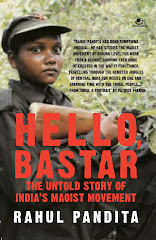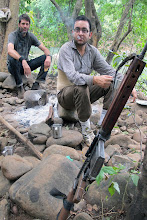Over 1,500 kilometres from Barrackpore, in Meerut, Dr Amit Pathak is performing an ultrasound on a young woman whose lungs have shrunk. A man possessed with history, medical reports share space on his table with a huge map of the city in 1904. “Very little geography has changed in Meerut for 150 years,” he says, rubbing off the grease from his patient’s abdomen. It was the grease on Enfield cartridges that finally claimed the first English victim of the 1857 revolt. Just outside the present-day Race Course in Meerut, Colonel John Finnis, the Commandant of the 11th Native Infantry Regiment, was shot dead by rebel sepoys.
Just outside the present-day Race Course in Meerut, Colonel John Finnis, the Commandant of the 11th Native Infantry Regiment, was shot dead by rebel sepoys.
Fifteen days after Mangal Pandey’s execution, 90 native sepoys were ordered to use the cartridges, said to be laced with cow and pig fat. Eighty-five of them refused and were court-martialled on May 9, most of them sentenced to rigorous imprisonment of ten years. It was so hot on Sunday, May 10, that the evening church-parade was postponed by half-an-hour to 7 pm. Dr Pathak drives his car through the market area where unidentified Fakirs appeared that Sunday evening urging masses to fight for their deen (religion). “Religion may be a taboo for intellectuals today, but in the 1857 context, you cannot separate religion from the revolution,” says he. As the mob swelled outside the church that fateful evening, there was little that any of the English officers could do. At 8 pm, the 85 prisoners were set free and the sepoys set their barracks on fire. The mob dashed at every European in order to take revenge.
Behind a walled house, Dr Pathak points towards a dry well. It was here that Mrs Chambers, the pregnant wife of the Adjutant of the 11th Native Infantry, was chopped into pieces by a butcher who was later hanged to death. On the same night, around two thousand soldiers marched to Delhi and rode straight to Bahadur Shah Zafar’s palace, asking him to lead them. In today’s Meerut, a taxi driver is found guilty of killing 250 people after robbing them in the past four months. “Meerut could never belong to Delhi and it refused to associate itself with other small towns towards the other side. The city hangs in balance with a heavy baggage of the past,” says a local poet.
On the same night, around two thousand soldiers marched to Delhi and rode straight to Bahadur Shah Zafar’s palace, asking him to lead them. In today’s Meerut, a taxi driver is found guilty of killing 250 people after robbing them in the past four months. “Meerut could never belong to Delhi and it refused to associate itself with other small towns towards the other side. The city hangs in balance with a heavy baggage of the past,” says a local poet.
Around 400 kilometres away from Meerut lies Jhansi. The city’s old market still sells Eveready batteries which are not red, and Weston television sets. In the bylanes, numerous ads of quacks claiming sureshot cure for premature ejaculation survive along hoardings of beauty parlours and English coaching centers. After the British forces surrounded the Jhansi fort, Rani Lakshmibai escaped with her adopted son, jumping from a high wall of the fort on the back of her horse Badal. But today, nobody is bothered about Jhansi’s brush with history. It is election time in Uttar Pradesh. Many supporters of a political party are lined up along the fort walls, emptying their bladders. A few workers who live inside the fort have pasted pictures of Aishwarya Rai. On the fort walls, Aslam has declared love for Mumtaz. And so has Ashok for Malti and Mukesh for Sunita. “You see, people have no respect for history,” rues Mohammed Asif as he lets out a huge glob of spit. Asif is a photographer-cum-tourist guide. “I am married with kids and there is no job. This morning I was coming to the fort and I saw this message behind a truck: Mehangai ki jai (Hail inflation) and it seemed so appropriate,” says Asif. What does he think of the 1857 revolution? “All gone waste, sir. The Angrez have left but has it made a difference to poor people like me? Not really.”
After the British forces surrounded the Jhansi fort, Rani Lakshmibai escaped with her adopted son, jumping from a high wall of the fort on the back of her horse Badal. But today, nobody is bothered about Jhansi’s brush with history. It is election time in Uttar Pradesh. Many supporters of a political party are lined up along the fort walls, emptying their bladders. A few workers who live inside the fort have pasted pictures of Aishwarya Rai. On the fort walls, Aslam has declared love for Mumtaz. And so has Ashok for Malti and Mukesh for Sunita. “You see, people have no respect for history,” rues Mohammed Asif as he lets out a huge glob of spit. Asif is a photographer-cum-tourist guide. “I am married with kids and there is no job. This morning I was coming to the fort and I saw this message behind a truck: Mehangai ki jai (Hail inflation) and it seemed so appropriate,” says Asif. What does he think of the 1857 revolution? “All gone waste, sir. The Angrez have left but has it made a difference to poor people like me? Not really.”
The journey of 220 kilometres from Jhansi to Kanpur takes seven hours in a state roadways bus. Kanpur is ‘chilled beer’ zone. After every ten metres or so, there is a liquor shop, with bright lights and mirror slabs, enticing the young and the old to take a bottle home or to the neighbourhood corner, wrapped in a newspaper carrying raunchy pictures of item girls. “All well at Cawnpore,” Major-General Hugh Massy Wheeler had written to the Governor-General during the third week in May 1857. But by the beginning of June, the English residents had received enough warnings to know that all was not well. Under the command of General Wheeler, the residents dug up an entrenchment. On June 6, it came under heavy attack from the rebel troops led by Nana Sahib. After being offered a safe passage to Allahabad, the residents decided to surrender. On June 27, they were taken to Satichaura Ghat, where around forty boats had been arranged for their departure. “The boats belonged to a boatman called Hardev Mallah, who also got a temple constructed here,” points out an old man. Bhagwan Das is 62 and runs a small shop near the Ghat. His son Chandan saved a child from drowning and was awarded a medal for this act of bravery by the President of India. “But no other facilities promised to us reached my family ever. It is tough living here,” says Das. 
Nobody is sure who fired the first shot at the Ghat on June 27, 1857, but immediately afterwards, the residents were attacked by the rebels and many were killed. The 125 children and women who survived the attack were pulled towards the river bank. Later, upon hearing about the advance of the British Army, the survivors were killed brutally and their bodies dumped into a well. It is rumoured that the youngest daughter of General Wheeler survived and married a Muslim trooper. Many years later, she had confided to a Christian priest on her deathbed that she was Miss Wheeler. When the British troops reoccupied Kanpur and other regions they committed atrocities on a much larger scale. Many captured rebels were made to crouch down and lick clean a square foot of the blood-soaked floor before being led to the gallows. Elsewhere, villages after villages were taken over by the British army and all the men were hanged from the tree branches. A memorial stone erected on the site of massacre was pulled down a day after India gained its freedom. “The last stone of that memorial is right outside my shop,” says Bhagwan Das. The stone serves as a platform for washing utensils.
Inside the temple compound, there still exists an old tree from which the leader of the rebel forces in Kanpur, Brigadier Jwala Prasad was hanged after being arrested by the British forces. At the site of the entrenchment lies a church today, built by the British in the memory of their own who perished in the revolt. Many English victims lie buried here. “Why do you want to click pictures here?” asks the church priest. “1857 is a closed chapter. I don’t want my church to be attacked in the name of patriotism. I hope you get the drift,” he explains. 
By the time the siege at the Lucknow Residency was over, the ageing king at Delhi had already been captured, his two sons and grandson shot near the Khooni Darwaza, which is more known now for the rape of a medical student in 2002. The king was exiled to Rangoon where he died unnoticed. The British forces massacred thousands of people in Delhi. Some of them were tied to the muzzle of cannons and blown off. Noted Urdu poet Mirza Ghalib could no longer get his ration of liquor from an English wine shop in Meerut. “Delhi is no longer a city; it looks like a cantonment,” he mentioned in a letter. “The rebellion was not successful because there was no sense of cohesive patriotism,” says Lucknow-based writer, Dr Yogesh Praveen. “No one knew what was happening elsewhere in the country except those who went for a chaar dhaam yatra. So it was essentially a fight for one’s own territory or rights. Expecting patriotism from those who participated in the uprising is like expecting your grandmother in bikini.”
So, is it that so many lives were lost in the name of God during 1857? “These days, more and more people are being killed in the name of democracy,” says Dr Pathak. Ten years after the uprising, the first railway whistle could be heard in Delhi on New Year’s eve in 1867. Two years after that, a boy was born in Porbandar, Gujarat, who, without firing a single shot, would finally force the British to leave India.
(This story first appeared in the Financial Express)





4 comments:
Amazing, amazing. I mean, this is magic. Keith, New York.
Great..
I loved the way you described Uttar Pradesh..I could clearly see the images..UP is the only state which confuses and interests me at the same time! :D
A new perspective to the events!! Great reading. I like the way the stories are linked.
A well researched article. You have have done a great job. Dr. Amit Pathak's research work is marvellous. He is indeed the torch bearer of Meerut. Kudos to his work and dedication. Rahul, I also liked your style of writing. Wish you all the best for your future articles.
Post a Comment